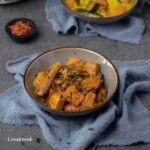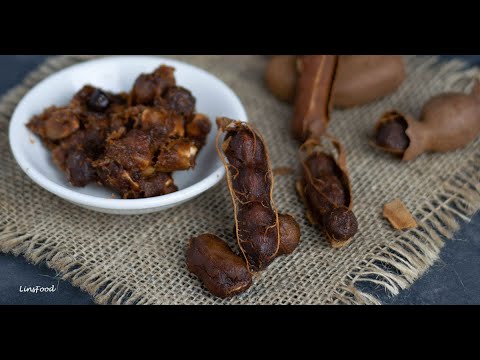Tamarind is a tropical fruit that is used as a souring agent in many cuisines around the world.
Estimated reading time: 5 minutes

What is Tamarind?
Tamarind is a fruit for starters, and grows on the tamarind tree as bean pods that contain many seeds encased in a moist, sticky brown pulp. It is this pulp that is prized for its sour and a little sweet properties.
Commonly thought to be African in origin, Tamarindus indica belongs to the legume or bean family which also includes soybeans, chickpeas, peanuts and peas. However, it is nothing like them!
Tamarind is known by so many different names, depending on the part of the world. For instance:
- assam in Singapore and Malaysia (in Malay)
- assam jawa in Indonesia (also in Singapore/Malaysia)
- tamarindo in Latin America
- sampaloc in the Philippines
- imli in Hindi
Incidentally, India is now the largest producer of tamarind.

What does Tamarind Taste Like?
Tamarind is high in tartaric acid, resulting in a very sour and slightly sweet flavour. This is why it’s highly prized in many cuisines around the world.
It lends tartness and a touch of sweet to so many dishes, like:
- soups
- curries
- chutneys
- sambals
- drinks

How to Use Tamarind?
It is often sold in blocks of compressed pulps in “ethnic” stores. All you have to do is tear a little of the pulp of, soak it in hot water, and mash it with your fingers.
Then you strain the brown liquid to obtain the brown, sour juice to add to whatever recipe you are using it in.
Take a look at the instruction card below, as well as the video to see how it’s done.
If you’ve got a jar of it in paste form, the best thing to do is to read the instructions. If they aren’t available, a rough guide is 1 Tbsp of jar paste = 1 Tbsp pulp.

Substitute for Tamarind
The best substitute for tamarind is the humble clear vinegar. Or Chinese rice vinegar.
You get the tartness with a hint of sweetness, without any unnecessary added flavours that lime or lemon juice will impart. Only use lime or lemon juice as a substitute for tamarind if the citrus flavour is a welcome addition. Like in sambals and noodles.
Do you use brown sugar as part substitute for tamarind? That’s an absolute NO! While tamarind is a little sweet when tasted neat, it really does not add sweetness to dishes. So there is no need for any form of sugar. Take it from a lifelong tamarind user.
Assam Jawa Seeds for Mancala

How long does Tamarind Water Keep?
Once you’ve extracted the tamarind water or tamarind juice, you can keep it in the fridge for up to a week. Be sure to cover it.
You could also freeze it in an ice cube tray for up to 3 months. Ideally, use a tray with a lid, or cover your ice cube tray with a cling film. This is to keep smells out. You have handy little portions of tamarind juice to use as and when you need it. Use straight from frozen.
My siblings and I grew up with my granny for the most part, and we had so many favourite games as kids during that time, that we’d play on a daily basis.
There was monopoly, carom and a favourite that we played with all our neighbours, mancala. Or as we called it by its Malay name, congkak.
We would inevitably lose the mancala pieces. As a result, my granny was always cleaning tamarind seeds to replace them. So assam jawa was very handy that way!
One of my most treasured memories.
Now let’s go take a look at how to use tamarind.
Recipes using Tamarind
Remember, this is a brand new site, started in Jan 2021. I shall add more as we go on, like Mee Siam Kuah and curries.



♥ If you found this article useful, don’t forget to leave me a comment and that all important, 5-star rating! Thank you! ♥
And feel free to tag me on Instagram @azlinbloor with your recipes. If using one of mine, hashtag it #linsfood.
Lin xx

What is Tamarind and How to use It
Equipment
- 2 bowls
- strainer – medium mesh
Ingredients
- 2 Tbsp tamarind pulp
- 125 ml very hot water (just after boiling)
Instructions
- Place your pulp in the first bowl and pour the hot water over it.
- Leave to soak for 5 minutes, mashing with a fork halfway through, to loosen the pulp.
- At the end of 5 minutes, mash it up well with your fingers. I find that the water, by this stage, isn't too hot to handle. If you do, add a little cold water (or water from the tap) to cool it down. Don't worry about the dilution if it's going to be cooked.If it's going in a chutney, then perhaps, let your boiling water cool down for 5 minutes, then soak the pulp for 10 minutes. Basically, the hotter the water, the less time it needs to soak.
- Either strain your tamarind mix through your sieve or strainer, pushing down on the pulp in the strainer.You don't want your sieve too fine, as you won't get the essence of the tamarind juice which will be too big to go through.You could also just strain it straight onto your recipe. OR get the pulp and any pieces of shell out with your fingers and pour your tamarind juice into whatever you're cooking, as the recipe calls for. This is my preferred method, the way my granny taught me.
- Any leftover can be kept, covered, in the fridge for a week.


2 thoughts on “What is Tamarind and how to Use It”